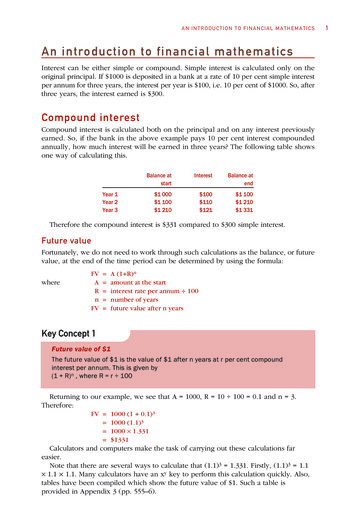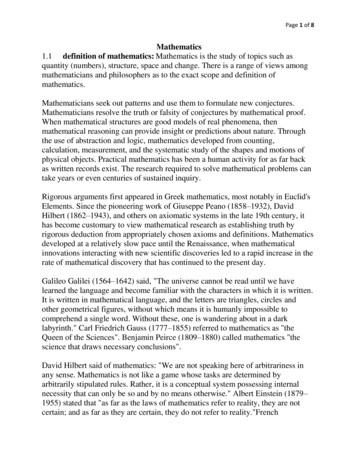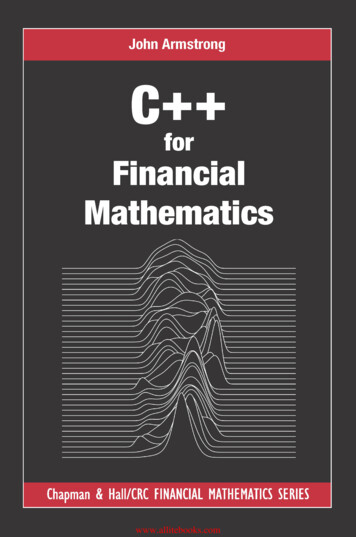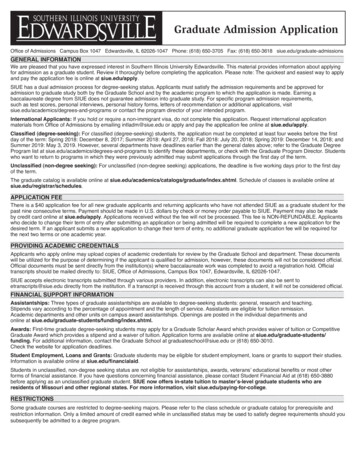
Transcription
AN INTRODUCTION TO FINANCIAL MATHEMATICSAn introduction to financial mathematicsInterest can be either simple or compound. Simple interest is calculated only on theoriginal principal. If 1000 is deposited in a bank at a rate of 10 per cent simple interestper annum for three years, the interest per year is 100, i.e. 10 per cent of 1000. So, afterthree years, the interest earned is 300.Compound interestCompound interest is calculated both on the principal and on any interest previouslyearned. So, if the bank in the above example pays 10 per cent interest compoundedannually, how much interest will be earned in three years? The following table showsone way of calculating this.Year 1Year 2Year 3Balance atstartInterestBalance atend 1 000 1 100 1 210 100 110 121 1 100 1 210 1 331Therefore the compound interest is 331 compared to 300 simple interest.Future valueFortunately, we do not need to work through such calculations as the balance, or futurevalue, at the end of the time period can be determined by using the formula:whereFVARnFV A (1 R)namount at the startinterest rate per annum 100number of yearsfuture value after n yearsKey Concept 1Future value of 1The future value of 1 is the value of 1 after n years at r per cent compoundinterest per annum. This is given by(1 R)n , where R r 100Returning to our example, we see that A 1000, R 10 100 0.1 and n 3.Therefore:FV 1000 (1 0.1)31000 (1.1)31000 1.331 1331Calculators and computers make the task of carrying out these calculations fareasier.Note that there are several ways to calculate that (1.1)3 1.331. Firstly, (1.1)3 1.1 1.1 1.1. Many calculators have an xy key to perform this calculation quickly. Also,tables have been compiled which show the future value of 1. Such a table isprovided in Appendix 3 (pp. 555–6).1
2AN INTRODUCTION TO FINANCIAL MATHEMATICSExample 1Use Appendix 3 to find the future value of 1, and hence calculate how much 10 000invested at 12 per cent per annum compounded annually will amount to in ten years.FV A (1 R)n A future value of 1From Table 1 in Appendix 3, we see that the future value of 1 after ten years at 12per cent is 3.1058. Hence:FV 10 000 3.1058 31 058The simple interest would only have been 12 per cent of 10 000 10 years 12 000,and the future value would be 22 000. This example illustrates the benefit of the compounding of interest compared with simple interest. However, note that we have not considered inflation or other charges.Present valueIn the previous section we looked at how much an amount would grow to in time. Weoften want to reverse the situation and ask how much needs to be invested now in orderto receive a certain amount in the future. This is particularly important in the calculation of capital projects which provide cash flows over several years. This is known aspresent value. To calculate present value, we use the formula:PV A [whereARnPV 1 ](1 R)nfuture amountinterest rate per annum 100number of yearspresent value, i.e. the amount which needs to be investedTo show that the above formula works, we will reverse the first compound interestquestion we considered.Key Concept 2Present value of 1The present value of 1 is the amount which needs to be invested now, at r per centper annum compound interest, in order to compound to 1 after n years. This isgiven by1, where R r 100(1 R)n
AN INTRODUCTION TO FINANCIAL MATHEMATICSExample 2What is the present value of 1331 received in three years’ time, at 10 per cent per annumcompound interest?PV A[1](1 R)n 1331[1](1.10)3 1331 0.7513 1000This confirms that we need to invest 1000 today to accumulate 1331 in three yearsat the compound interest rate of 10 per cent. Therefore, 1000 is the present value of 1331 received in three years at a discount rate of 10 per cent.There are tables which give the present value of 1 for a range of interest rates andyears. Table 2 in Appendix 3 (pp. 557–8) provides these values.Example 3Use Table 2 to find the present value of 1 and hence the present value of 31 058received after ten years at 12 per cent compound interest per annum.PV A [1](1 R)n A present value of 1From Table 2, we see that the present value of 1 after ten years at 12 per cent is0.32197. Hence:PV 31 058 0.32197 9999.74If we refer back to Example A2.1 then the answer we would expect is 10 000. Thedifference of 26 cents is what we describe as a rounding error. It occurs because theinterest factors in the tables are rounded to four or five decimal places.AnnuitiesFuture valueIn the previous examples we either calculated the future value of a single amountinvested today, or we determined the present value of a sum to be received in the future.In many instances, money will be invested or withdrawn regularly over the investmentperiod. Where the same amount is invested or withdrawn on a regular basis, we have anannuity. There are different types of annuities. An ordinary annuity is where each of theequal payments is made at the end of each compounding period. An annuity due iswhere each of the equal payments is made at the beginning of each compoundingperiod.3
4AN INTRODUCTION TO FINANCIAL MATHEMATICSExample 4Troy wants to invest 1000 at the end of each year for five years at a compound interestrate of 10 per cent per annum. How much will Troy’s investment be worth in five years?We could perform five calculations and then add these together. However, we candetermine the sum of an annuity by using the formula:FVA A [1 (1 R) (1 R)2 . (1 R)n –1](1 R)n – 1]Ramount of annuityinterest rate per annum 100number of yearsfuture value of annuityorFVA A [whereARnFVA Once again, there are tables which provide future value of ordinary annuity factors.Table 3 in Appendix 3 (pp. 559–60) shows the future value of 1 per period.Key Concept 3Future value of 1 per periodThe future value of 1 per period is the value of an investment after n time periods,given that 1 is invested at the end of each time period, at a compound interest rateof r per cent. The future value of 1 per period is(1 R)n – 1, where R r 100RFor Example A2.4 we have A 1000, R 0.1 and n 5.(1.10)5 – 1]0.10 1000 future value per 1 period 1000 6.1051 6105.10FVA 1000 [Example 5If Stacey invests 500 at the end of each year at 8 per cent per annum compoundedannually, how much will she have at the end of five years? (Use Table 3.)(1 R)n – 1]R A future value of 1 per periodFVA A [From Table 3, the future value of 1 per period after five years at 8 per cent is 5.8666.Hence:FVA 500 5.8666 2933.30
AN INTRODUCTION TO FINANCIAL MATHEMATICSPresent valueWe can also reverse Example A2.5 and imagine that Stacey wishes to provide herdaughter with an annuity of 500 for five years. How much should Stacey invest now,at 8 per cent per annum, compounded annually, so that the daughter can withdraw 500at the end of each year for the next five years? This amount is called the present valueof an annuity.The formula is:PVA A [111 ]21 R(1 R)(1 R)n1–orPVA A [whereARnPVA 1(1 R)n]Ramount paid out per yearinterest rate 100number of yearspresent value of annuity, i.e. amount to be invested nowTable 4 in Appendix 3 shows the present value of 1 per period.Key Concept 4Present value of 1 per periodThe present value of 1 per period is the amount which needs to be invested now,at r per cent per annum compound interest, so that a sum of 1 can be withdrawnat the end of each year, for n years. The present value of 1 per period is11 – (1 R)nRwhere R r 1001(1 0.08)5PVA 500 []0.08 500 present value of 1 per period 500 3.9927 1996.35Therefore, Stacey needs to invest 1996.35 now at 8 per cent compound interest perannum, for five years, in order for her daughter to receive 500 a year for five years.More frequent compoundingThe tables make the solution to financial mathematical problems reasonably easy.However, what do we do when the interest is compounded quarterly, monthly or daily?We illustrate what can be done by using the equations for future value and present value.5
6AN INTRODUCTION TO FINANCIAL MATHEMATICSFuture valueFV A [1 whereARnmFV R m n]mamountinterest rate per annum 100number of yearsnumber of times per year that interest is compoundedfuture valueExample 6How much will 1000 amount to in five years at 12 per cent per annum, compoundedquarterly?0.12 5 4]4 1000 (1.03)20 1000 1.8061 1806.10FV 1000 [1 Note that, using Table 1, we look up a 3 per cent interest rate with n 20.Present valuePV A [whereARnmPV 1[R1 m]]m namountinterest rate per annum 100number of yearsnumber of times interest is compounded per yearpresent valueUsing the data from Example A2.6, what is the present value of 1000 to be received infive years’ time?PV 1000 [[10.121 41 1000 [](1.03)20 1000 0.55367 553.67(Use 3% and n 20 in Table 2.)]5 4]
FVA future value of annuity Once again, there are tables which provide future value of ordinary annuity factors. Table 3 in Appendix 3 (pp. 559-60) shows the future value of 1 per period. Key Concept 3 Future value of 1 per period The future value of 1 per period is the value of an investment after n time periods,











